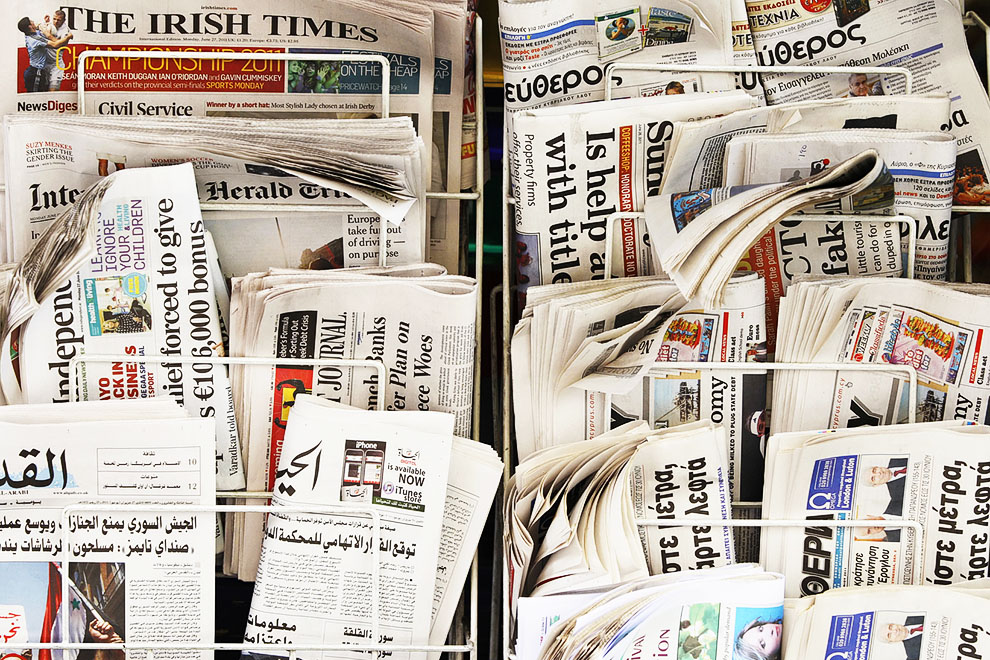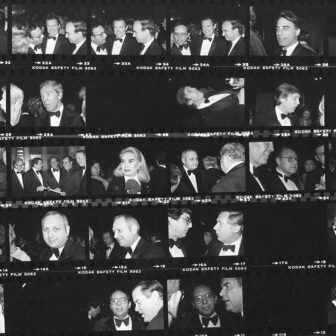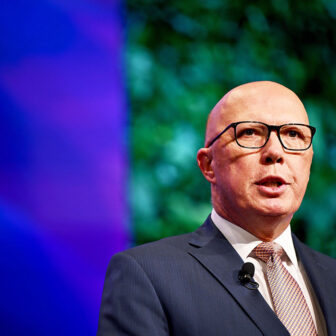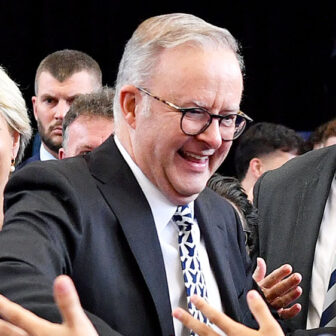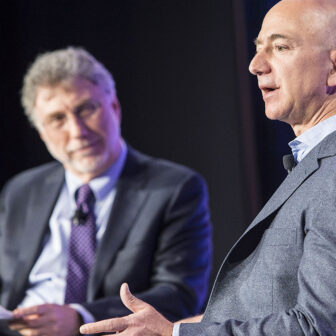In 2005, Crikey proprietor and former Sydney Morning Herald editor Eric Beecher delivered an hour-long presentation to the Fairfax board. His message? The board needed to countenance the possibility of a “catastrophe scenario.”
There was a risk, Beecher ventured, that classified advertising would migrate to the web, drastically cutting into the revenues Fairfax newspapers had enjoyed for decades. The model that made quality print journalism possible could be about to come asunder.
The message, he says, was not heeded. But the catastrophe scenario has now happened. Compounding the damage wrought by the exodus of the classifieds, news publishers are compelled to compete with the Googles and Facebooks that offer advertisers a previously undreamt-of scale of audience, combined with minute segmentation.
At 200 pages, the Saturday Sydney Morning Herald is now half the size it once was. Thousands of employees, including around 500 core editorial staff, have been laid off. Fairfax’s share price stands at about a fifth of what it was when Beecher presented his warning to the board.
Digital advertising revenue will never deliver anything like the profits enjoyed in the days of print. For Beecher, this means that large-scale news publishers face the serious prospect of commercial oblivion. In June he told Media Watch: “They are heading towards the cliff really fast… I think that cliff is, for everybody, within a year or two or less.”
On the same program, respected financial commentator Alan Kohler seconded that prognosis. “What you might call public interest journalism is going to be funded by public interest bodies, such as the government or philanthropists or other people sort of like that. But I think that there’s no commercial future for that at all,” Kohler said.
In 1894 a scribe for the London Times surveyed the seemingly intractable problem of horse manure accumulating in the city’s streets. With 11,000 horse-drawn cabs traversing the city each day, buses requiring 50,000 horses in total, and private horse transport to boot, it was a serious problem. The writer predicted that, if nothing changed, London would be nine feet deep in horse manure by 1950. But then, of course, the mass production of the motor car changed things.
Notwithstanding Beecher’s convincing record of forecasting the woes of the newspaper industry, the prediction of a commercial cliff places a perilously heavy reliance on nothing changing. Specifically, it depends on an assumption that revenue from readers, through digital subscriptions and the like, can’t grow to substantially compensate for the irreversible loss of advertising revenue.
Currently, 10 per cent of Australians pay for online news. That places Australia somewhere in the middle internationally, with Norway having the highest rate of digital news purchasers (27 per cent) and Britain having the lowest (7 per cent). A quarter of Australians who don’t presently pay for online news tell researchers they are likely to do so in the future. The question is whether news publishers will succeed in convincing that group to actually cough up (and convincing the avowed freeloaders to change their minds).
It is hard to foretell how technology will change the landscape. The soon-to-be-launched Flattr Plus will enable users to load up an account with a monthly contribution for content creators. The pitch is: “You set your budget for great web content. Our smart algorithm automatically distributes the right amounts to the right sites. You don’t have to worry about a thing.” The sheer ease of the concept – and the backing of Adblock Plus, software downloaded over 500 million times – may nudge readers towards paying more for the great journalism they enjoy.
Australian aggregator Inkl is aiming to be for news what Spotify is for music. Users access content from a plethora of publishers, including the Herald and Crikey, for ten or fifteen cents per article, or a monthly subscription. Inkl’s Dutch equivalent, Blendle, has over 600,000 customers in Europe and launched in the United States in March.
Services like Blendle, Inkl and Flattr Plus might make an incremental difference to the revenues publishers can squeeze out of readers. They likely won’t be game changers, but they do serve as useful reminders that there is a lot we don’t know about the future.
But the argument that publishers can adapt to new commercial incentives does not ultimately rest on the potential magic of technological innovation. The best reason to hope that readers will pay for news is that they once did. Throughout the nineteenth century, a world of newspapers mostly funded by readers flourished. As late as 1879 in the United States, advertising made up only 44 per cent of total newspaper revenue. Only as the age of mass consumption dawned did advertising revenue increase to the point that it outstripped reader subscriptions. By 1929, advertising as a proportion of total newspaper revenue in the United States had grown to 74 per cent.
Globally, the period between 1900 and 2015 was an era in which news publishers gained most of their revenue from advertisers. The size of the majority varied from country to country. While advertising tended to constitute as much as 80 per cent of the total revenue of US newspapers, in Europe and Britain the proportion was traditionally lower, ranging from 60 to 75 per cent. However, the primary reliance on advertising revenue was an international phenomenon.
Japan was an anomaly. Japanese newspaper readers were willing to pay an unusually high cover price, an inclination buttressed by an all-encompassing distribution and sales network. As a result, in the period when it dominated in other newspaper industries, advertising revenue in Japan generally didn’t amount to even half of total revenue.
Accordingly, Japanese newspapers have proved more resilient as advertising has migrated online. The country’s leading paper has a circulation of ten million and that of its nearest rival is 7.5 million. While advertising revenue halved between 2000 and 2013, the decline in total revenue has not been nearly as pronounced. Indeed, one analyst believes that the greatest threat facing the industry is complacency: “in a country where print sales and profits are so high… there are precious few incentives to innovate.”
Where the strength of reader revenue in Japan was a global exception, it is now becoming the rule. In May this year, the New York Times reported that 57 per cent of its revenue now comes from reader subscriptions. That’s up from 38 per cent in 2010 (immediately before it launched its digital paywall). The percentage increase is partly attributable to declining advertising revenue, to be sure, but it’s also true that new digital reader revenue is almost making up for lost print revenue.
As media analyst Ken Doctor has observed, we are re-entering an era of majority reader revenue. Some digital publishers may continue to rely on a model in which they mostly focus on high traffic and ad sales, but many will not.
What are the new incentives publishers face in a world in which their primary objective is to convince readers to subscribe? How are these incentives different from the old ones?
Before mass advertising, the nineteenth-century press was much more partisan. Readerships tended to be more clearly defined by their adherence to a particular political worldview. This wasn’t a coincidence. In a world in which most revenue came from readers, it made economic sense.
Imbuing a news product with a political identity sheltered publishers from price competition. For a left-wing reader, a marginal decrease in the conservative newspaper’s price barely made it more attractive, and vice versa.
As long as readers were willing to pay a premium price for a news product that was distinct from its rivals, typically by virtue of its partisan or ideological stance, it was more profitable for publishers to appeal to a market segment than to the mass market. With drastic reductions to its cover price, a conservative newspaper might have attracted left-wing readers. But that price would have been so low that the increase in circulation would have entailed a reduction in total revenue.
As a result, the nineteenth-century era of majority reader revenue was characterised by high competition. There were more newspapers, more proprietors and more towns and cities with at least two newspapers than came to be the norm in the twentieth century.
The huge growth in advertising revenue throughout the late nineteenth and early twentieth century altered the equation. Whereas readers placed a premium on differentiated content, generally partisan in character, advertisers demanded access to a readership that transcended political allegiances. And they were willing to pay for it.
The natural strategy for publishers, in seeking to gain the largest possible readership to sell to advertisers, was to shed their partisan character. Profitability was to be found in selling the largest possible audience to advertisers. The new tactic was to tack to the centre and adopt a stance of political neutrality that wouldn’t offend partisans of any stripe.
As a corollary, the newspaper industry in the era of majority advertising revenue tended towards monopoly. Publishers joined in pursuit of the same mass audience – with advertising revenue at stake, product differentiation no longer made sense. Given the economies of scale deriving from the high first-copy costs and low marginal costs of producing newspapers, the market leader was best positioned to compete on price and further invest in quality, thus further increasing its readership and catalysing a cycle of monopolistic dominance. This phenomenon in the newspaper industry has been described by investor Warren Buffett as “survival of the fattest.”
Over the same fifty-year period between 1879 and 1929 when advertising became the major source of newspaper revenue, the percentage of American cities with more than one daily newspaper declined from 61 per cent to 21 per cent. In 1910, there were 689 cities in the United States where there were separately owned and operated newspapers. By 1989, there were only twenty-six cities with more than one newspaper.
In Australia in 1903, there were twenty-one daily newspapers, with seventeen different owners. In 2011, there were eleven dailies, owned by only two proprietors. By 2008, New Limited’s market share had reached 67 per cent, with Fairfax claiming another 24 per cent of newspaper readership.
The historical lesson, according to the late media scholar C. Edwin Baker, is that advertising revenue reduced “the economic influence of readers’ desire for differentiated, that is, diverse, newspaper perspectives.” Conversely, it would seem, the new era of majority reader revenue will strongly reward differentiation in news products.
“Basically, in today’s ecosystem, uniqueness is the substitute for geographical monopolies,” says Josh Marshall, editor and publisher of long-form journalism site Talking Points Memo. In July, Marshall revealed to Harvard’s NiemanLab that the site has 11,000 subscribers paying $50 annually, making a substantial contribution to total revenue.
Clearly, in lots of ways, the contemporary era of majority reader revenue is not analogous with the nineteenth century. Information abundance makes it especially tough to persuade readers to pay up. Marshall observed that subscribers to his site are motivated as much by a commitment to the site as by the premium experience: “A big chunk of it is that people want to be connected with and support a publication they love.”
Marshall also commented:
I think it’s possible that we could totally paywall TPM and be a more profitable business by doing exactly what we’re doing right now but not let people read anything unless they’re a member. But we wouldn’t do that, even if it would make a more profitable company, because the whole reason we do this is we want to have our coverage be out there and hitting, in relative terms, a big audience and affecting news cycles.
Putting Marshall’s observations together, it appears that core subscribers are, in part, handing over money to Talking Points Memo so it can continue to propagate a worldview they identify with. It’s easy to think of paying for news as something like paying for books, a matter of information acquisition. But news sites also offer a way of participating in political life and membership of a community. Subscribing may be more akin to donating to GetUp! or Bernie than to conventional news consumption.
In any case, turmoil in the news industry is set to continue for the foreseeable future. It’s less clear that disruption is going to affect all players equally. The publishers that are most reliant on digital advertising are much more exposed to competition from social networks and search engines. That’s not a comfortable place to be. Chances are that it will be these outfits that find themselves falling off the cliff first, thus strengthening the competitive position of sites with strong reader revenue.
We shouldn’t write off the news industry just yet. We are still to see the long-term response to the new set of commercial incentives in play. It may turn out that reader revenue just doesn’t grow enough to significantly substitute for lost advertising revenue. But these are early days. Readers have only just regained their long-lost status as the most economically important consumers of news. •
